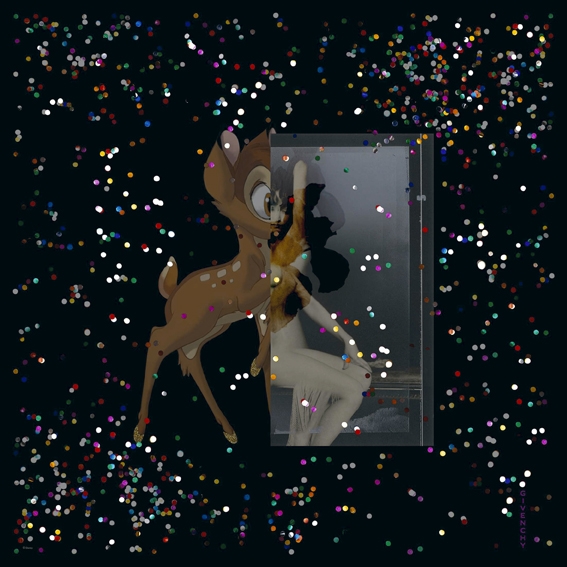This last season, fashion hype was reserved not for a garment, or even an actual object, but an image – a simple cut-and-paste amalgamation of Disney’s Bambi and a naked but ill-defined woman. Generated by the house of Givenchy, the image did, of course, come attached to clothes – a black T-shirt, a neoprene sweatshirt and a lace top – but they were mere facilitators, weather-and-occasion-appropriate backing for the main event. Priced at £400 for the T and £750 for the sweatshirt, the Bambi-print pieces sold out almost before the general public knew that they existed. During October, fashion feeds across the digital world showed a rich broth of both mutton and lamb dressed as venison, as famous, camera-loving ladies rocked the deer.
For young designers needing to get noticed, there is pressure to create images that have immediate impact online
There have been status garments for as long as clothing has existed (though perhaps not at price tags this cartoonish), but the Bambi print is significant not for its status or its price, but as the most visible example of the impact of digital and social media on contemporary dress. Changes in the speed, reach and quality of fashion images have had an actual effect on the way garments are worn and designed.
Over the last ten years, images of fashion have increasingly been seen on screens rather than the printed page. With the rise of smartphones, those screens have become smaller and smaller, and the most widely disseminated images have diminished commensurately in quality. As anyone involved in book and magazine publishing well knows – but very few within the fashion world have digested – there is an enormous difference between digital images viewed even on a large screen, and a well-printed photograph.
Onscreen it is very difficult to make out any kind of surface detail. Subtle handwork, fine embellishment, quality fabrics, careful tailoring, details at an intimate scale and all the other quirks of thoughtful fabrication – the very elements, in other words, that formerly distinguished designer fashion from the high street – become to all intents and purposes invisible.
They shot his mum, now they’re shooting Bambi
The speed of image consumption and of changing trends has accelerated dramatically. Expensively crafted garments from prominent couture collections, which in previous decades might have been evaluated by fashion editors before receiving their public debut in an imaginatively styled photoshoot, will now be seen by fashion fans via blurry Instagram feeds that flash up online before the pieces have left the runway. Fashion houses both major and modest must now court the Insta-snappers, the Tumblrs and the Pinterested as well as the glossies. For young designers needing to get noticed, there is pressure to create images that have immediate impact online, and some openly admit to adjusting the aesthetic of their collections accordingly.
The new media favour the brightly coloured, the boldly patterned, the strongly shaped and the distinctively accessorised. All of these elements coincide neatly with trends from the last few years: colour blocking, the rise of neon, assertive and clashing patterns, the return in popularity of hats, rococo sunglass frames, outsize garments, pod-shaped coats and ‘luxury’ sweatshirts bearing large, recognisable pictures. In response to viewing platforms that remove surface detail, fashion has gone Cartoon Time.
Street-style photography has flourished in tandem with the rise of this Hanna-Barberian tendency in fashion, and arguably it has pushed these trends far more strongly than it has followed any tendencies laid out by print fashion publications. The stars of the street-style blogs dress not only to be photographed, but in a way that ensures the resulting image will appear to advantage on a tiny screen.
Style has thus been conflated with recognisability; online fans cannot ‘like’ what they cannot see. Givenchy’s outsize Bambi image was immediately identifiable, even at a distance – wearing it expressed an understanding of style founded on nous, clout and the desire to be photographed. Such photogenic popularity brought the harbinger of its own death – everybody shot Bambi, so the hype has moved on to the next thing.
This article was first published in the December 2013 issue.
